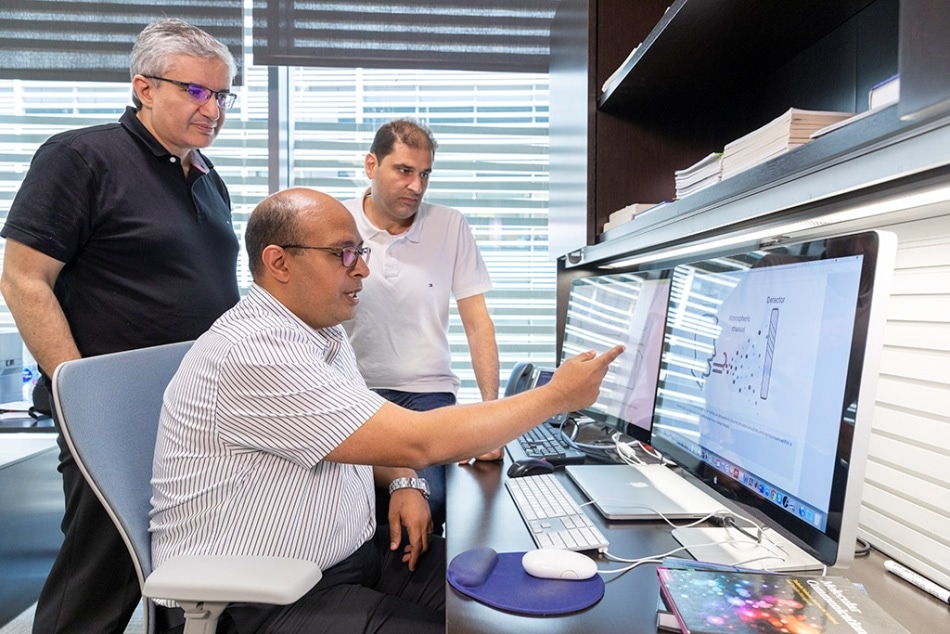Aug 5 2019
Human breath is said to carry a wealth of information. To harness that information, KAUST research scientist Osama Amin has teamed up with Basem Shihada and Mohamed-Slim Alouini from KAUST, and colleagues Sajid Ahmed and Maryam Khalid from Information Technology University, Pakistan.
 Osama Amin discusses the system architecture with advisors Mohamed-Slim Alouini and Basem Shihada (back). (Image credit: KAUST)
Osama Amin discusses the system architecture with advisors Mohamed-Slim Alouini and Basem Shihada (back). (Image credit: KAUST)
Ever since the late 18th century, inventors and researchers have been developing ways to improve human telecommunication from the telephone, the telephone, the cellular phone, and currently the Internet. In the recent past, multidimensional media had created a lot of hype.
The need for this kind of state-of-the-art media has pushed scientists to explore ways to introduce other senses, like taste, touch, and smell, into the conventional sight and sound senses.
Researchers have already discovered methods to obtain data about the human body from breath. For example, the breathalyzer, which is designed to determine blood-alcohol levels, was developed in the 1950s. Of late, clinicians have been utilizing breath samples obtained from patients to detect human influenza and other similar viruses, and also to diagnose cancers, like lung and breast tumors.
So far, nearly 1,000 volatile organic compounds have been detected in healthy human breath and these differ based on age, sex, diet, health, height, lifestyle, and body fat.
The researchers envision an even wider concept. A unique system architecture has already been designed by the team that can hypothetically identify an individual infected with a virus from the middle of a crowded area, for example, an airport.
Our idea is to construct a communication system using inhaled and exhaled breath, where the information is carried in molecules.
Osama Amin, Research Scientist, KAUST
The development of such a breath communication system will pave the way to a new kind of wireless body networks, explained Amin. These are the communications systems utilized by medical practitioners, for instance, to wirelessly track individuals’ health using implanted and wearable sensors that are designed to transfer data to a remote device.
Although a breath communication system cannot substitute this kind of setup, it can provide an even greater degree of freedom for actual applications, like those required for observing patients under quarantine.
Currently, the researchers are establishing multidisciplinary collaborations with specialists in several fields so as to define the most optimized communication channel models that can be applied to this method.
The questions being asked by them are what kinds of data can be exchanged? What kinds of detectors and sensors are required to send and receive data? What kinds of molecular compounds would be added into the system to communicate with the human body? And what privacy and security concerns had to be deal with?
In addition, the researchers are utilizing the data that can be collected from individuals’ exhaled breath to teach machine learning algorithms on how to determine physical activities, track human health, and even track the psychological status of a person, stated Amin.
These machine learning algorithms can subsequently be used along with sensors in upcoming mobile phones, he added.
Just like we’re training cell phones to recognize signatures, voices and people’s faces; breath training could be used to identify individuals and to monitor their overall state of wellbeing.
Osama Amin, Research Scientist, KAUST
A breath of fresh information to help diagnosis
Researchers discuss how useful data can be collected from analyzing breath. (Video credit: KAUST)